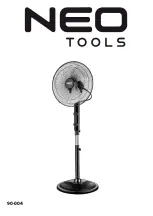
9
REGULATION OF ROTATION OF FAN UNIT
1. Regulate speed of fan.
The rotation of the fan can be sped up or slowed down by
increasing or decreasing the power at the remote control, regulating the speed of fan heads
and varying the position of the motor heads. See number 2 below
2. Vary position of motor heads.
The greater the angle (either up or down) of the motor
heads to the horizontal support rods, the greater the speed of rotation. The less the angle of
the fan head, the less the speed of rotation.
CARE OF AND TROUBLESHOOTING YOUR FAN
1. Check hardware bi-yearly.
Because of the fan's mechanical movement some connections
may become loose over time. Check the support connections, brackets and blade attachments
twice a year. Make sure they are secure. It is not necessary to remove fan from the wall.
2. Clean your fan periodically.
This will help to help maintain its new appearance over the
years. Use only a lightly water-moistened, lint free cloth to avoid scratching the finish. Plated
finishes are sealed with lacquer to minimize discoloration or tarnishing. Do not let rain or running
water to come in contact with the fan. Rain or running water could damage the motor, wood
blades or possibly cause an electrical shock.
3. There is no need to oil your fan.
The motor has permanently lubricated bearings.
4. Fan makes a vibration noise.
Check to see that all screws are tight in the fan cage
connection to the motor face plate.
5. Fan vibrates or makes grinding noise as blades rotate.
Uninstall and reinstall the blades.
Make sure that your fan head's set screw is counter-sunk into the bore hole in the flat part of the
motor shaft. Be careful that the blade brackets themselves are not bent in this process. Do not
operate your fan if it continues to vibrate. Contact your Atlas Fan Co purveyor if the re-installation
of the blades does not resolve the problem.
6. Clicking noise from inside of center of fan.
As unit rotates at higher R.P.M.s, clicking
noises are normally heard from the braking mechanism within the fan body. If the noise is
bothersome, slow the unit down. To do this, see "Regulation of Rotation" section above.
7. Fan is not rotating or doing so unevenly.
See "Regulation of Rotation" section above and
verify that coupling cover has at least 1/8 - 1/4" clearance between it and fan motor assembly,
otherwise coupling cover will act as a brake, impeding rotation.
8. Lights shut off and will not come back on.
This unit is equipped with a wattage limiting
device. Lamping in excess of 190 watts will disable your ceiling fan's light kit. To reset your light
kit you must turn the power off and re lamp, keeping the wattage under 190 watts. Restore power
to your ceiling fan and continue normal operation.




























